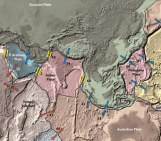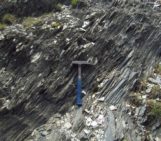
In 1976 Oriol Riba published his paper on “Syntectonic unconformities of the Alto Cardener, Spanish Pyrenees: a genetic interpretation”, and despite appearing as a niche topic at first glance, it was voted as one of the papers in our Must-Read series. A major reason for that is that the paper presents a general model for syntectonic unconformities – an unconformity which illustrates both sedimentation and tectonic activity – that turned out to be a widely applicable textbook reference. For this post we asked the geological community on Twitter for images of the beautiful Pyrennes. Thanks to Laura Burrel, Pablo Rodríguez-Salgado, Silvia Crosetto, and all who helped in the search!

A collection of images of the Spanish Pyrenees. 1) Riglos unconformity, 2) A progressive unconformity in Sant Llorenç de Morunys, 3) Olvena Aragon, 4) Santa Anna progressive unconformity in Serres Marginals, 5) An unconformity in Valle de los Sarrios, 6) The Chasa de rodellar anticline in Sierra de Guara. (Credit of images: 1, 4 & 6 – Laura Burrel (@Lau_Burrel), 2 & 3 – Pablo Rodríguez-Salgado (@PLowstand), 5 – Silvia Crosetto).
The introduction is a short summary of the research that was previously done in the region, covering the conflicting viewpoints on the evolution of some conglomeratic units in the Spanish Pyrenees. The main purpose of the paper is simple and clear: establishing the close correlation between simultaneous sedimentation and tectonic development. The next section of the paper brings us deeper into the field area, notably with some detailed maps and structural cross-sections. It also describes the three main types of unconformities observed, from young and simple to old and complex: a single progressive unconformity, a deformed syntectonic unconformity, and a composite progressive unconformity. The first type develops when deformation exceeds sedimentation (as in Fig. 1a), the second type when sedimentation exceeds deformation (as in Fig. 1b), and the third type when one outcrop contains both cases.
Riba concludes that none of the evolutionary models that were previously proposed match his detailed observations, and can explain all types of unconformities and their lateral changes, so he goes on to suggest his own evolutionary model. The sketches for this model are simple and effective, and basically illustrate how different tectonic phases, with accelerating and decelerating deformation, can lead to different angular relationships within unconformities (see Figure 1). The author ends with both general conclusions of broad interest, and a short point on the regional significance of his findings.

Figure 1: Effects of accelerated and slowed uplift on growth strata. Sketch by Shi et al., (2019), based on the ideas of Riba, (1976)
The model turned out to be well-cited, both in local Pyrenean studies and concerning comparable settings in other locations, and was used in textbooks such as “Principles of sedimentary basin analysis” and “The geology of stratigraphic sequences”. In that respect, it is a classic example showing how doing a proper job when trying to solve a local issue, sometimes results in a model that can be broadly applied and is widely appreciated.
In the discussion on the Reddit forum there are contributions by Gino de Gelder, Sebastien Castelltort and Gianluca Frasca, feel free to add your thoughts. Sebastien points out that this was probably one of the first papers to emphasize how strata can be used to invert tectonic motion. In a broader sense, this paper seems to have been a game changer, as it formed a bridge between structural geology and sedimentology. Gianluca suggests two additional papers that have links to the Riba paper, and make for excellent follow-up reading to the enthusiasts of growth strata.
By Gino de Gelder, Adriana Guatame-Garcia, Gianluca Frasca, and the TS Must Read team
References
Miall, A. D. (2010). The Geology of Stratigraphic Sequences. Springer Science & Business Media.
Miall, A. D. (2013). Principles of Sedimentary Basin Analysis. Springer Science & Business Media.




Rafik BAOUCHE
very interesting examples of geological features